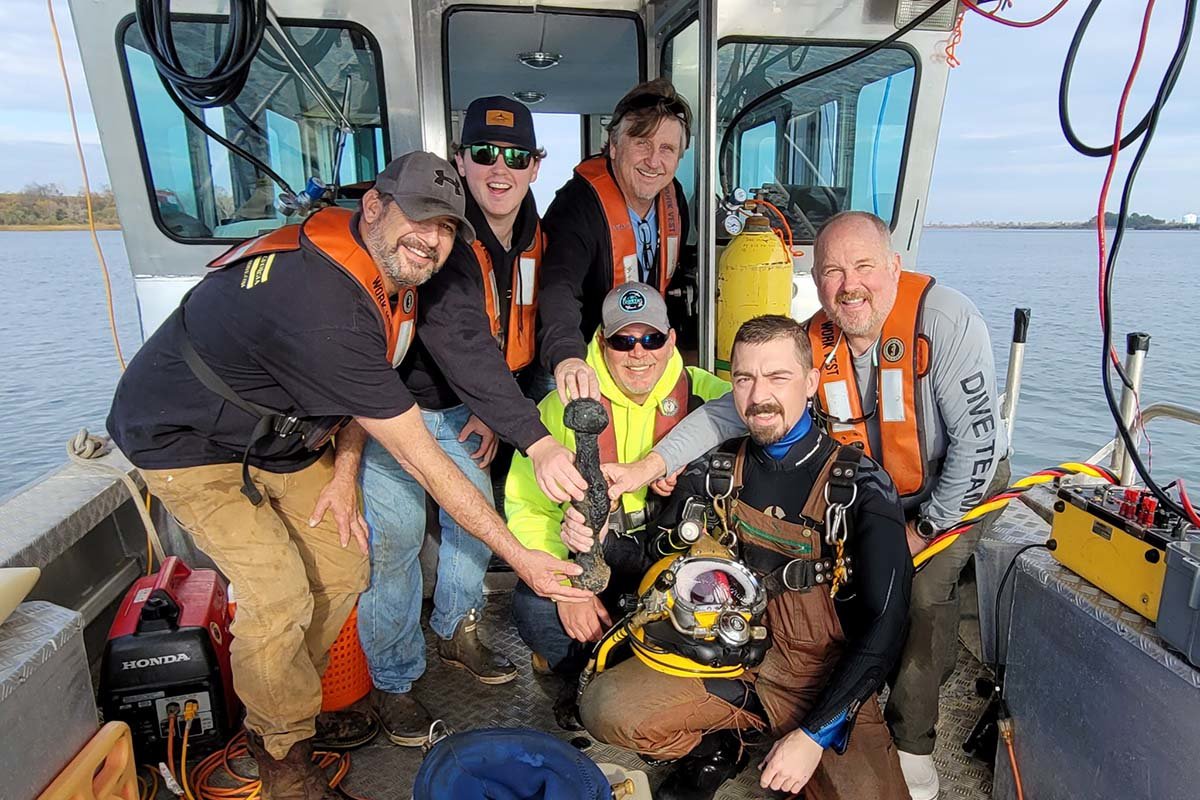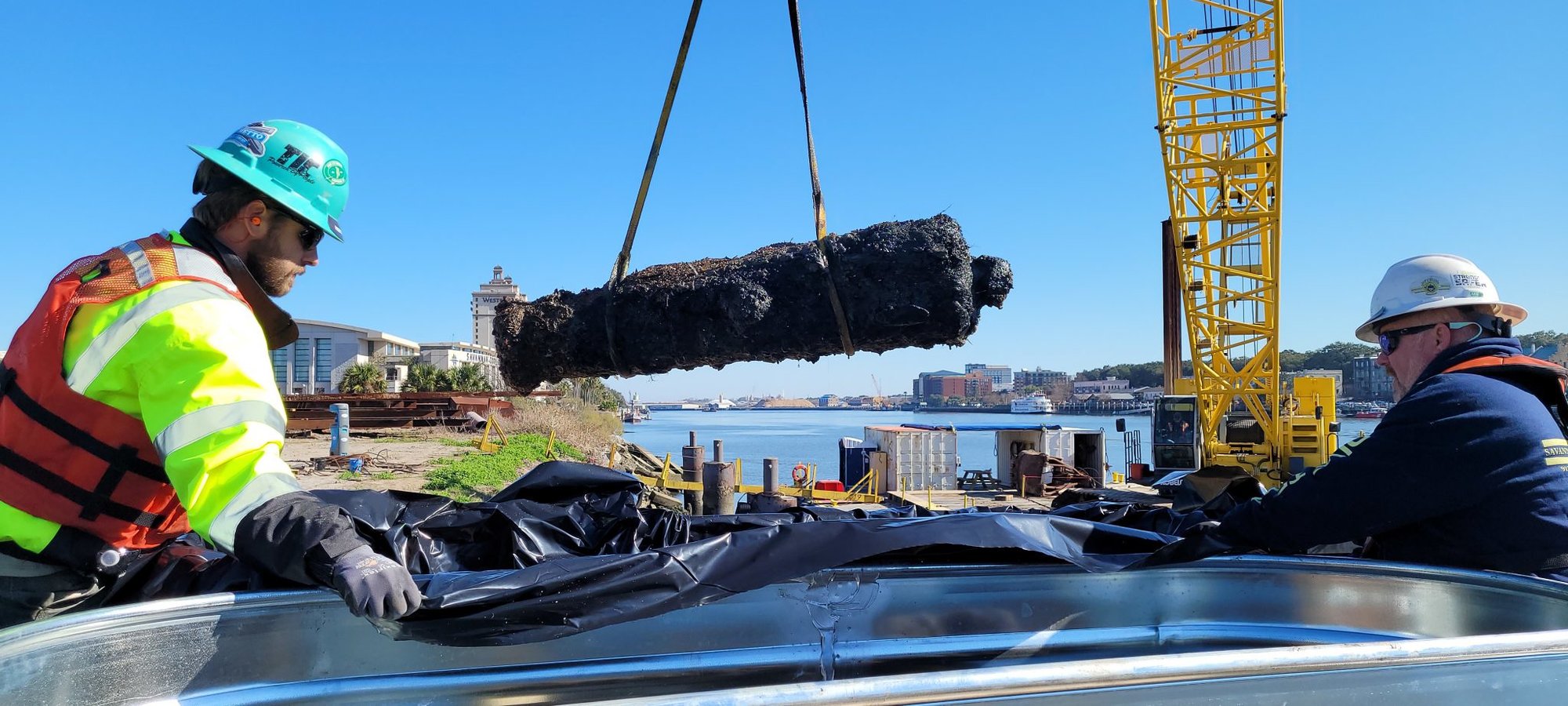How the Savannah River Became a Graveyard for American Revolutionary War Cannons

The US Army Corps of Engineers discovered 15 cannons in the Savannah River. The team also found bar shot ammunition, seen here, fired from cannons usually at ship’s masts or rigging on a target ship. The recovered artillery pieces are believed to be from the American Revolution. Photo courtesy of the US Army Corps of Engineers/Flickr.
In January 2022, archeologists recovered 12 cannons believed to be from more than one American Revolutionary War shipwreck in the Savannah River. That makes a total of 15 cannons joining such artifacts as anchors and ammunition recently discovered in the city’s waters from a crucial period in Georgia’s early history.
The mystery of the artillery graveyard began to unfold in late February 2021, when a dredge from a multiagency harbor expansion project unearthed three iron guns and fragments of anchors in an area in front of Old Fort Jackson, known as “Five Fathom Hole,” within sight of downtown Savannah.
A Savannah District team from the US Army Corps of Engineers, along with archeologists from Commonwealth Heritage Group and local divers, began the process of recovering the cannons from the river and attempting to identify their origins.
This team had experience working together on numerous projects, including the recovery of the Civil War-era ironclad CSS Georgia in the summer of 2015. More recently, they helped reveal new details about how Civil War-era cribs — rows of wooden boxes filled with rocks or bricks sunk by Confederate defenders — obstructed Union naval forces from attacking the city.

For the latest find, the team consulted with British Royal Navy experts, which led them to suspect the guns came from the HMS Rose, a famous British warship intentionally sunk in the Savannah River in 1779. The Rose was scuttled as part of the attempt to block French ships from coming to the aid of Americans in the siege of Savannah. The British hoped to retain Virginia, the Carolinas, and Georgia under British control.
However, research recently discounted the Rose, which historical documents confirmed sank farther up the river without any weapons on board.
Instead, British archives indicate the weapons came from two or more vessels that had transported British troops. Those vessels were also deliberately sunk as a blockade tactic after a large French fleet approached.
“The French had blockaded the port of Savannah, getting ready to attack,” said archeologist Stephen James, according to a Savannah Corps YouTube video. “They scuttled these troop transports to keep the French out and basically save the city early on from being taken over.”
The archeologists from Commonwealth Heritage Group created a detailed map of the artifacts on the river bottom using sonar and hands-on measurements by trained divers. Local salvage divers were then called upon to assist in the resurfacing of the cannons. In the middle of the busy channel, dives could only occur at high or low tide and had to stop if freighters were transiting the area.
The murkiness of the water also made the work difficult.
“You got zero [visibility], the current’s ripping you, you’re holding on for dear life half the time trying to hike your way through down there,” recalled salvage diver Richard Steele. “It’s been a race against the clock every time you get in the water.”
The divers wrapped sturdy straps around the cannons, then used inflatable lift bags to raise the guns from the thick muck. A large crane hoisted the recovered cannons out of the water and into metal troughs. Trucks brought them to the Corps of Engineers depot for examination.
“The river also yielded up other smaller but equally important artifacts,” said Michael Jordan, the video’s producer, “including several pieces of bar shot, a type of ammunition that looks a lot like a modern dumbbell.”
The ammunition, when fired, rotates through the air and is often effective against other warships because there is a significant increase in chances of hitting the mast of the vessel.
“We are going to identify a few that would be great candidates for conservation,” said Andrea Farmer, a Savannah District archaeologist working on the project. “We hope that they will be put on exhibit locally in Savannah so that people can see them. We’re just interested to learn more about the story.”
Read Next: American, Australian Researchers Clash Over Historic Ship Discovery

Matt Fratus is a history staff writer for Coffee or Die. He prides himself on uncovering the most fascinating tales of history by sharing them through any means of engaging storytelling. He writes for his micro-blog @LateNightHistory on Instagram, where he shares the story behind the image. He is also the host of the Late Night History podcast. When not writing about history, Matt enjoys volunteering for One More Wave and rooting for Boston sports teams.
BRCC and Bad Moon Print Press team up for an exclusive, limited-edition T-shirt design!
BRCC partners with Team Room Design for an exclusive T-shirt release!
Thirty Seconds Out has partnered with BRCC for an exclusive shirt design invoking the God of Winter.
Lucas O'Hara of Grizzly Forge has teamed up with BRCC for a badass, exclusive Shirt Club T-shirt design featuring his most popular knife and tiomahawk.
Coffee or Die sits down with one of the graphic designers behind Black Rifle Coffee's signature look and vibe.
Biden will award the Medal of Honor to a Vietnam War Army helicopter pilot who risked his life to save a reconnaissance team from almost certain death.
Ever wonder how much Jack Mandaville would f*ck sh*t up if he went back in time? The American Revolution didn't even see him coming.
A nearly 200-year-old West Point time capsule that at first appeared to yield little more than dust contains hidden treasure, the US Military Academy said.












